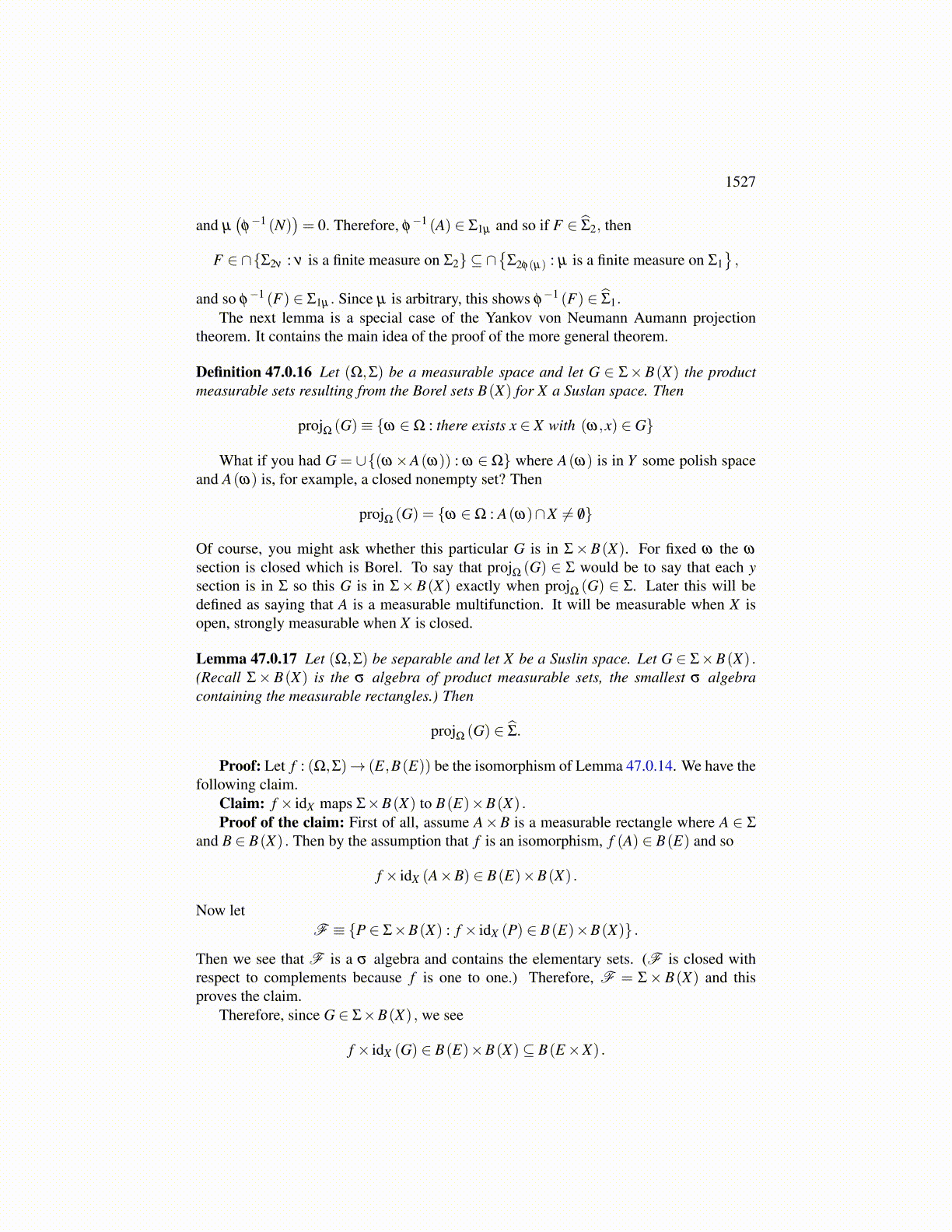
1527
Corollary 47.0.11 Let Ω be a compact metric space and let A be a Suslin subset of Ω.
Then A ∈ B̂(Ω).
Proof: Let µ be a finite measure defined on B(Ω) . By Theorem 47.0.9 A ∈ B(Ω)µ.
Since this is true for every finite measure, µ, it follows A ∈ B̂(Ω) as claimed. This provesthe corollary.
We give another technical lemma about the completion of measure spaces.
Lemma 47.0.12 Let µ be a finite measure on a σ algebra, Σ. Then A ∈ Σµ if and onlyif there exists A1 ∈ Σ and N1 such that A = A1 ∪N1 where there exists N ∈ Σ such thatµ (N) = 0 and N1 ⊆ N.
Proof: Suppose first A = A1∪N1 where these sets are as described. Let S ∈P (Ω) andlet µ∗ denote the outer measure determined by µ. Then since A1 ∈ Σ⊆ Σµ
µ∗ (S) ≤ µ
∗ (S\A)+µ∗ (S∩A)
≤ µ∗ (S\A1)+µ
∗ (S∩A1)+µ∗ (N1)
= µ∗ (S\A1)+µ
∗ (S∩A1) = µ∗ (S)
showing that A ∈ Σµ .Now suppose A∈ Σµ . Then there exists B1 ⊇ A such that µ∗ (B1) = µ∗ (A) , and B1 ∈ Σ.
Also there exists AC1 ∈ Σ with AC
1 ⊇ AC and µ(AC
1
)= µ∗
(AC). Then A1 ⊆ A⊆ B1
A⊆ A1∪ (B1 \A1) .
Nowµ (A1)+µ
∗ (AC)= µ (A1)+µ(AC
1)= µ (Ω)
and so
µ (B1 \A1) = µ∗ (B1 \A1)
= µ∗ (B1 \A)+µ
∗ (A\A1)
= µ∗ (B1)−µ
∗ (A)+µ∗ (A)−µ
∗ (A1)
= µ∗ (A)−
(µ (Ω)−µ
∗ (AC))= 0
because A ∈ Σµ implying A = A1∪
N1︷ ︸︸ ︷(B1 \A1)∩A and N1 ⊆ N ≡ (B1 \A1) ∈ Σ with µ (N) =
0. This proves the lemma.Next we need another definition.
Definition 47.0.13 We say (Ω,Σ), where Σ is a σ algebra of subsets of Ω, is separableif there exists a sequence {An}∞
n=1 ⊆ Σ such that σ ({An}) = Σ and if w ̸= w′, then thereexists A ∈ Σ such that XA (ω) ̸=XA (ω
′) . This last condition is referred to by saying {An}separates the points of Ω. Given two measure spaces, (Ω,Σ) and (Ω′,Σ′) , we say theyare isomorphic if there exists a function, f : Ω→ Ω′ which is one to one and f (E) ∈ Σ′
whenever E ∈ Σ and f−1 (F) ∈ Σ whenever F ∈ Σ′.